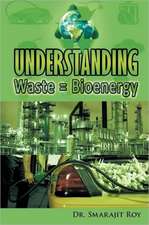Introduction to R for Social Scientists: A Tidy Programming Approach: Chapman & Hall/CRC Statistics in the Social and Behavioral Sciences
Autor Ryan Kennedy, Philip D. Waggoneren Limba Engleză Paperback – 9 mar 2021
Whether used as a reference manual or read from cover to cover, readers will be equipped with a deeper understanding of R and the Tidyverse, as well as a framework for how best to leverage these powerful tools to write tidy, efficient code for solving problems. To this end, the authors provide many suggestions for additional readings and tools to build on the concepts covered. They use all covered techniques in their own work as scholars and practitioners.
| Toate formatele și edițiile | Preț | Express |
|---|---|---|
| Paperback (1) | 389.62 lei 3-5 săpt. | +17.67 lei 7-13 zile |
| CRC Press – 9 mar 2021 | 389.62 lei 3-5 săpt. | +17.67 lei 7-13 zile |
| Hardback (1) | 1057.89 lei 6-8 săpt. | |
| CRC Press – 9 mar 2021 | 1057.89 lei 6-8 săpt. |
Din seria Chapman & Hall/CRC Statistics in the Social and Behavioral Sciences
- 8%
 Preț: 399.11 lei
Preț: 399.11 lei -
 Preț: 360.32 lei
Preț: 360.32 lei -
 Preț: 373.34 lei
Preț: 373.34 lei -
 Preț: 349.02 lei
Preț: 349.02 lei -
 Preț: 371.62 lei
Preț: 371.62 lei - 9%
 Preț: 641.03 lei
Preț: 641.03 lei -
 Preț: 360.28 lei
Preț: 360.28 lei -
 Preț: 356.63 lei
Preț: 356.63 lei - 9%
 Preț: 623.63 lei
Preț: 623.63 lei - 9%
 Preț: 641.04 lei
Preț: 641.04 lei - 8%
 Preț: 413.11 lei
Preț: 413.11 lei - 8%
 Preț: 404.91 lei
Preț: 404.91 lei - 9%
 Preț: 1277.83 lei
Preț: 1277.83 lei - 8%
 Preț: 548.32 lei
Preț: 548.32 lei -
 Preț: 463.51 lei
Preț: 463.51 lei - 8%
 Preț: 420.83 lei
Preț: 420.83 lei -
 Preț: 414.70 lei
Preț: 414.70 lei - 12%
 Preț: 312.43 lei
Preț: 312.43 lei - 15%
 Preț: 433.90 lei
Preț: 433.90 lei - 18%
 Preț: 1112.34 lei
Preț: 1112.34 lei - 18%
 Preț: 797.43 lei
Preț: 797.43 lei - 21%
 Preț: 337.43 lei
Preț: 337.43 lei - 15%
 Preț: 620.74 lei
Preț: 620.74 lei - 13%
 Preț: 310.81 lei
Preț: 310.81 lei - 15%
 Preț: 503.22 lei
Preț: 503.22 lei - 14%
 Preț: 315.28 lei
Preț: 315.28 lei - 15%
 Preț: 546.07 lei
Preț: 546.07 lei - 18%
 Preț: 1229.46 lei
Preț: 1229.46 lei - 18%
 Preț: 784.97 lei
Preț: 784.97 lei -
 Preț: 452.53 lei
Preț: 452.53 lei - 12%
 Preț: 312.43 lei
Preț: 312.43 lei - 25%
 Preț: 531.38 lei
Preț: 531.38 lei -
 Preț: 441.20 lei
Preț: 441.20 lei - 28%
 Preț: 881.69 lei
Preț: 881.69 lei
Preț: 389.62 lei
Preț vechi: 423.51 lei
-8% Nou
74.55€ • 78.05$ • 61.69£
Carte disponibilă
Livrare economică 15-29 martie
Livrare express 01-07 martie pentru 27.66 lei
Specificații
ISBN-10: 0367460726
Pagini: 208
Dimensiuni: 156 x 234 x 19 mm
Greutate: 0.36 kg
Ediția:1
Editura: CRC Press
Colecția Chapman and Hall/CRC
Seria Chapman & Hall/CRC Statistics in the Social and Behavioral Sciences
Public țintă
Postgraduate and Undergraduate AdvancedCuprins
Notă biografică
Philip Waggoner is an assistant instructional professor of computational social science at the University of Chicago and a visiting research scholar at ISERP at Columbia University. He is an Associate Editor at the Journal of Mathematical Sociology and the Journal of Open Research Software, and author of the forthcoming book, Unsupervised Machine Learning for Clustering in Political and Social Research (Cambridge University Press). His work has appeared or is forthcoming in many journals including the Journal of Politics, Journal of Mathematical Sociology, and Journal of Statistical Theory and Practice.
Recenzii
-Sunil Gupta, SAS, CDISC and R Corporate Trainer and Author, Founder of R-Guru.com
Descriere
Introduction to R for Social Scientists: A Tidy Programming Approach introduces the Tidy approach to programming in R for social science research to help quantitative researchers develop a modern technical toolbox. The Tidy approach is built around consistent syntax, common grammar, and stacked code, which contribute to clear, efficient programming. The authors include hundreds of lines of code to demonstrate a suite of techniques for developing and debugging an efficient social science research workflow. To deepen the dedication to teaching Tidy best practices for conducting social science research in R, the authors include numerous examples using real world data including the American National Election Study and the World Indicators Data. While no prior experience in R is assumed, readers are expected to be acquainted with common social science research designs and terminology.
Whether used as a reference manual or read from cover to cover, readers will be equipped with a deeper understanding of R and the Tidyverse, as well as a framework for how best to leverage these powerful tools to write tidy, efficient code for solving problems. To this end, the authors provide many suggestions for additional readings and tools to build on the concepts covered. They use all covered techniques in their own work as scholars and practitioners.















